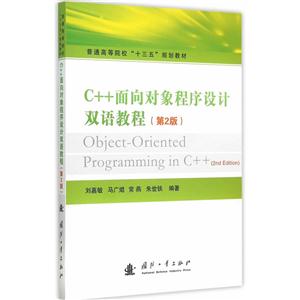-
>
全国计算机等级考试最新真考题库模拟考场及详解·二级MSOffice高级应用
-
>
决战行测5000题(言语理解与表达)
-
>
软件性能测试.分析与调优实践之路
-
>
第一行代码Android
-
>
C Primer Plus 第6版 中文版
-
>
深度学习
-
>
MATLAB计算机视觉与深度学习实战-赠在线交流卡和本书源码
C++面向对象程序设计双语教程-(第2版) 版权信息
- ISBN:9787118103656
- 条形码:9787118103656 ; 978-7-118-10365-6
- 装帧:一般胶版纸
- 册数:暂无
- 重量:暂无
- 所属分类:>>
C++面向对象程序设计双语教程-(第2版) 本书特色
由刘嘉敏、马广焜、常燕、朱世铁编著的《c++ 面向对象程序设计双语教程(第2版普通高等院校十三五规划教材)》从面向对象程序设计的特点出发,分章节循序渐进地介绍了面向对象的相关概念及运用c ++实现的过程,并辅以大量程序清单。同时书中在各个章节起始处明确了章节学习目标,且在全书中重要知识点处均有提示,各章末尾有本章出现的重要的词汇注解和本章相应的练习题,有助于读者理解书中内容,帮助读者掌握面向对象编程方法。全书共分8章, 具体内容包括:导论、基本工具、类和对象(1)、类和对象(2)、运算符重载、继承、多态性和虚函数、模板。
C++面向对象程序设计双语教程-(第2版) 内容简介
本书从面向对象程序设计的特点出发,分章节循序渐进地介绍了面向对象的相关概念及运用C++实现的过程,并辅以大量程序清单。同时书中在各个章节起始处明确了章节学习目标,且在全书中重要知识点处均有提示,各章末尾有本章出现的重要的词汇注解和本章相应的练习题,有助于读者理解书中内容,帮助读者掌握面向对象编程方法。 全书共分8章,具体内容包括:导论、基本工具、类和对象(1)、类和对象(2)、运算符重载、继承、多态性和虚函数、模板。
C++面向对象程序设计双语教程-(第2版) 目录
- >
诗经-先民的歌唱
诗经-先民的歌唱
¥15.1¥39.8 - >
【精装绘本】画给孩子的中国神话
【精装绘本】画给孩子的中国神话
¥17.6¥55.0 - >
罗曼·罗兰读书随笔-精装
罗曼·罗兰读书随笔-精装
¥40.6¥58.0 - >
名家带你读鲁迅:朝花夕拾
名家带你读鲁迅:朝花夕拾
¥10.5¥21.0 - >
姑妈的宝刀
姑妈的宝刀
¥11.4¥30.0 - >
唐代进士录
唐代进士录
¥19.1¥39.8 - >
山海经
山海经
¥20.4¥68.0 - >
罗庸西南联大授课录
罗庸西南联大授课录
¥13.8¥32.0
-
C和指针
¥69.3¥99 -
新编C语言习题与解析
¥48.3¥69 -
C程序设计-(第五版)
¥19.1¥39 -
2022图书×抽奖盲袋
¥9.9¥25 -
2023读书月阅读盲盒——天黑,闭眼,刀谁?
¥42.3¥158
















